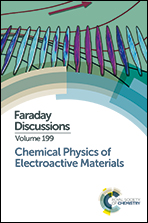Electrostatic interactions between ions near Thomas–Fermi substrates and the surface energy of ionic crystals at imperfect metals
Abstract
The electrostatic interaction between two charged particles is strongly modified in the vicinity of a metal. This situation is usually accounted for by the celebrated image charges approach, which was further extended to account for the electronic screening properties of the metal at the level of the Thomas–Fermi description. In this paper we build upon a previous approach [M. A. Vorotyntsev and A. A. Kornyshev, Zh. Eksp. Teor. Fiz., 1980, 78(3), 1008–1019] and successive works to calculate the 1-body and 2-body electrostatic energy of ions near a metal in terms of the Thomas–Fermi screening length. We propose workable approximations suitable for molecular simulations of ionic systems close to metallic walls. Furthermore, we use this framework to calculate analytically the electrostatic contribution to the surface energy of a one dimensional crystal at a metallic wall and its dependence on the Thomas–Fermi screening length. These calculations provide a simple interpretation for the surface energy in terms of image charges, which allows for an estimation of the interfacial properties in more complex situations of a disordered ionic liquid close to a metal surface. The counter-intuitive outcome is that electronic screening, as characterized by a molecular Thomas–Fermi length lTF, profoundly affects the wetting of ionic systems close to a metal, in line with the recent experimental observation of capillary freezing of ionic liquids in metallic confinement.
- This article is part of the themed collection: Chemical Physics of Electroactive Materials


 Please wait while we load your content...
Please wait while we load your content...